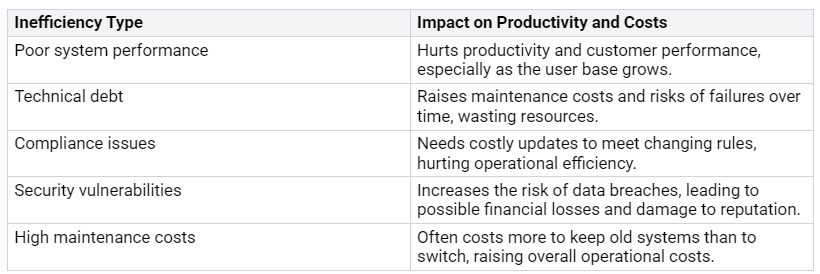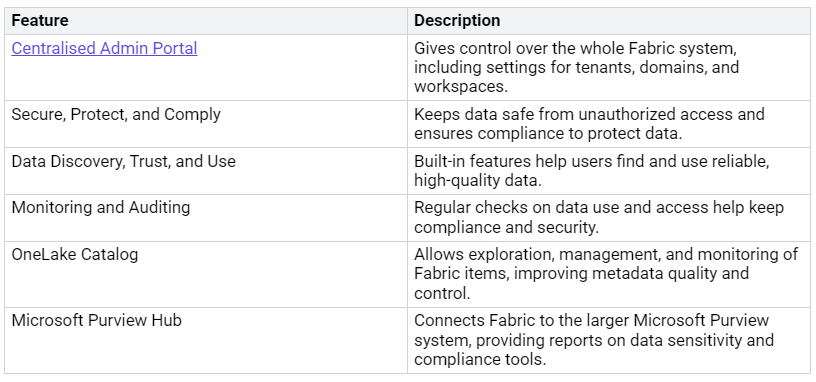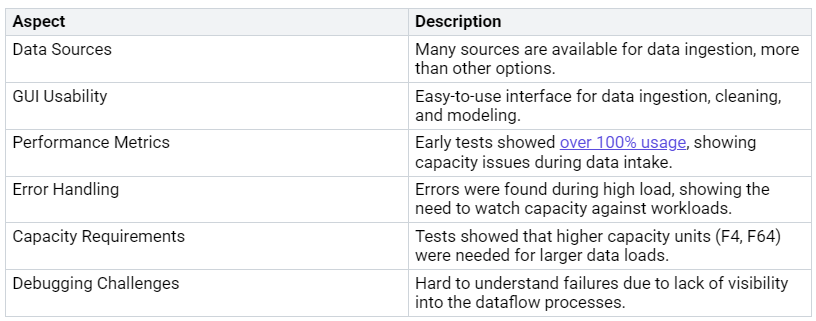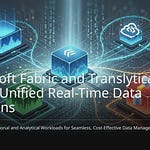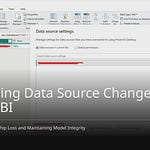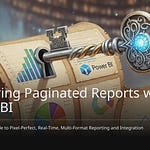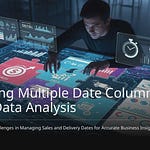In today’s fast-moving data world, you need tools that help you work better and grow. Microsoft Fabric Dataflows Gen2 gives a new way to handle your ETL tasks. It makes workflows easier by fitting well into the Microsoft Fabric system. The improvements in efficiency are clear; for example, the best dataflow in Gen2 uses 28.7k compute units. This ability is much better than old ETL tools, which often have trouble with big datasets. With features made for large-scale use, Gen2 is a big deal in today’s data management.
Key Takeaways
Microsoft Fabric Dataflows Gen2 makes ETL tasks easier. It helps manage data better and faster.
The platform can handle big datasets. It allows businesses to grow their data without spending too much money.
Real-time data features give quick insights. This helps teams make faster and smarter choices.
Collaboration tools let both tech and non-tech users work well together on data projects.
Built-in governance tools keep data safe and follow rules. They protect your organization from problems.
The Problem with Traditional ETL
Inefficiencies in Legacy Systems
Traditional ETL systems often have trouble keeping up with today’s data needs. These old systems show many problems that can hurt your organization’s work and raise costs. Here are some common issues:
Scalability issues: As your data grows, old systems may not manage the extra load well. This can cause high maintenance costs.
High maintenance costs: Keeping outdated systems often needs special resources and security, which can raise expenses.
Limited flexibility: Old systems usually cannot handle different data types. This makes it hard to change with business needs.
Performance bottlenecks: Slow data extraction and long load times can slow down decision-making. This affects how quickly you can respond to market changes.
Data quality problems: Different formats and duplicate records can hurt data reliability. This leads to bad insights and decisions.
Integration complexities: The different data types and structures of old systems make data integration harder.
Vendor lock-in: Special code can limit how systems work together. This ties your organization to certain vendors and reduces flexibility.
These problems can greatly affect your organization. For example, a recent study showed that 61% of data engineering time goes to integration tasks. This shows a big waste of resources that could be used for important projects.
Fragmented Workflows
Fragmented workflows are another big problem in traditional ETL processes. When you manage many ETL processes with different tools, you face several issues:
Data quality issues: About 41% of ETL projects have data quality problems. These issues can hurt the accuracy and trust of your analytics.
Extended implementation timelines: The difficulty of combining and checking data from different sources can delay project timelines. This can slow down your organization’s ability to act on insights.
Undetected entry errors: Errors can go unnoticed in broken systems. Special characters in free-text fields or small changes can ruin your data pipelines, leading to bad decisions and wasted resources.
Undetected entry errors, special characters in free-text fields, or subtle schema drift can silently corrupt your pipelines, leading to poor decisions and wasted resources.
Why Microsoft Fabric Dataflows Gen2 Matters
Unified Transformation Logic
Microsoft Fabric Dataflows Gen2 brings a unified transformation logic that makes the ETL process easier. This feature helps you manage data changes in a simpler way. With this unified method, you can lower complexity and save resources a lot.
Multi-threaded Processing: The SortCL engine does multi-threaded, in-memory changes. This ability speeds things up and helps you work with large datasets better.
User Empowerment: Non-technical users can change and access data on their own. This makes data management easier for everyone in your organization.
Governance and Control: Built-in governance tools keep data safe while making it easy to access. You can keep control without losing flexibility.
The performance boosts from the Modern Query Evaluation Service help with large data tasks. You will see quicker design-time experiences with Preview-only steps, which cut down wait times and improve maintenance. Overall, these features help modern data engineering pipelines, showing better scalability and maintenance.
Integration with Microsoft Fabric
The integration of Microsoft Fabric Dataflows Gen2 with other parts of Microsoft Fabric is impressive. This integration improves the efficiency of data pipelines, letting you create scalable, high-performance data pipelines easily.
Natively Fabric-first: Dataflows Gen2 save results straight into OneLake as Delta tables. This feature makes data ready to use in Lakehouses, Warehouses, Notebooks, and Power BI.
Collaboration: Many team members can work together on building and managing Dataflows in Fabric workspaces. Automatic governance and access control make teamwork smoother.
Dataflow Activity: This feature helps manage Dataflows with built-in support for Dataflow Gen2 parameters. You can connect to different data sources, clean data, and store it well.
With these integration features, you can easily bring in data from sources like Excel, SQL databases, and SaaS APIs. The unified platform makes creating data management workflows easier, boosting your overall efficiency. Dataflows Gen2 also support incremental refresh and parallel processing, ensuring data is available on time for analytics, which is important for large datasets.
Core Advantages of Gen2
Scalability and Performance
Microsoft Fabric Dataflows Gen2 has great scalability and performance. You can easily handle large data processing tasks. Here are some important features that improve your experience:
Fast Copy: This feature helps you take in large amounts of data quickly. You can manage terabytes of data without any trouble.
Distributed Architecture: This design boosts performance when there is a lot of work. It makes Gen2 perfect for big companies.
Data Destinations: You can choose different places for your changed data. This flexibility makes data management easier and more accessible.
Generative AI Integration: This feature helps with preparing data. It automates boring tasks and creates smart code, saving you time.
With these abilities, you can make decisions faster and work more efficiently. The low-code/no-code approach also cuts down development time, letting you focus on more important tasks.
Governance and Collaboration
Governance and collaboration are very important in today’s data world. Microsoft Fabric Dataflows Gen2 does well in these areas, keeping your data safe and easy to access. Here are some governance features that help with compliance and data security:
Collaboration is easy with Microsoft Fabric Dataflows Gen2. You can standardize data formats to Parquet, making sharing between Power BI, Azure Synapse, and Data Factory simple. This cuts down on repeated work and boosts teamwork. The Microsoft Co-Pilot AI Assistant helps both technical and non-technical users work together. You can ask questions and create reports or graphs based on your needs.
By using these advantages, you can create a culture of teamwork and innovation in your organization.
Real-Time Data Capabilities
Ingesting Streaming Data
Microsoft Fabric Dataflows Gen2 is great at taking in streaming data. This ability helps you get live data quickly. It is important for making fast decisions. The platform uses Eventstreams to bring in real-time data. This means you get immediate insights as things happen.
AI-Powered Analytics: The system uses artificial intelligence to process incoming data. It filters and analyzes data quickly and accurately. This helps you understand things faster.
Eventhouses: Data is saved in Eventhouses. This makes it easy to query and access. You can get the information you need right away.
Keeping Dashboards in Sync
It is important to keep your dashboards updated in real-time for good analytics. Microsoft Fabric Dataflows Gen2 makes this easy. Here’s how it works:
Dynamic Visualization: Real-time dashboards show data in a lively way. You can interact with and explore insights as they happen. This helps you make better decisions.
Efficient Data Handling: The platform manages both batch and streaming data well. This flexibility lets you work with different data sources without issues.
With these features, you can keep your analytics tools updated with the latest data. This ability helps you make smart decisions based on the most current information.
Impact on Teams and Business
Empowering Analysts and Engineers
Microsoft Fabric Dataflows Gen2 helps analysts and engineers by making data access and management easier. With tools like the Modern Query Evaluation Service, you get faster dataflow run times. This means you can spend more time analyzing data instead of waiting for it to process. The parallelized query runs greatly improve performance, letting you work with larger datasets more easily.
This easier access to data means you can get insights without needing a lot of technical knowledge. You can create reports and visualizations on your own, which encourages a culture of innovation in your team.
Reducing Dependency on Key Individuals
Microsoft Fabric Dataflows Gen2 lowers the need for specialized ETL workers. Tools like self-service data preparation let business analysts and BI professionals do complex data tasks by themselves. This change makes your team more flexible and quick to respond to business needs.
With these features, you can make workflows smoother and improve teamwork. The modular design of Dataflows supports best practices in data architecture. This way, teams can create reusable parts and computed tables. As a result, you can focus on important projects instead of getting stuck on technical issues.
Future Outlook for Microsoft Fabric
Redefining ETL Standards
Microsoft Fabric Dataflows Gen2 creates a new way to do ETL processes. You will see big changes in how companies handle their data. This platform makes it easier to get and change data. You can focus on analyzing data instead of worrying about technical stuff. With Gen2, you can do complex changes before data goes to your BI tools. This change lessens the load on your systems and improves performance.
Efficient extraction: You can gather data in one place, which cuts down on API calls and makes it more reliable.
Optimized storage: Keeping data in OneLake ensures it is consistent and easy to access.
Decoupling and reusability: You can create a pre-processed data layer that boosts report performance.
These improvements mean you can trust your data more and make decisions faster.
Establishing a Unified Ecosystem
The future of Microsoft Fabric is about building a connected data ecosystem. This ecosystem will link different data sources smoothly. You will find it easier to manage data across various platforms. The integration features of Gen2 will help you work with data from many sources without problems.
Powerful transformation capabilities: You can change data easily, making sure it is ready for analysis.
Collaboration: Teams can work together better, sharing insights and resources.
Enhanced analytics: With real-time data access, you can make smart decisions quickly.
As you start using Microsoft Fabric Dataflows Gen2, you will see how it encourages innovation and teamwork in your organization. This connected approach will not only make your workflows smoother but also help your teams use data more effectively.
In conclusion, Microsoft Fabric Dataflows Gen2 changes how you do ETL tasks. You get a single platform that makes data management easier. Important benefits are:
Scalability: Easily manage large datasets.
Real-time capabilities: Get live data for quick insights.
Collaboration: Help teams work together well.
Use this amazing tool to improve your data plans. The future of data management is here, and it’s better than ever! 🌟
FAQ
What is Microsoft Fabric Dataflows Gen2?
Microsoft Fabric Dataflows Gen2 is a new ETL tool that makes data changes easier. It works well with the Microsoft Fabric system, helping you manage and analyze data better.
How does Gen2 improve data processing speed?
Gen2 speeds up data processing with its multi-threaded design and smart query evaluation. This setup lets you work with large datasets quickly and easily.
Can non-technical users utilize Dataflows Gen2?
Yes! Dataflows Gen2 lets non-technical users handle data on their own. Its easy-to-use interface and self-service tools help you create reports and visuals without needing a lot of technical knowledge.
What are the key benefits of using Dataflows Gen2?
The main benefits are better scalability, real-time data access, and improved teamwork. These features help you make workflows smoother and make faster, data-driven choices.
How does Gen2 support real-time analytics?
Gen2 helps with real-time analytics by taking in streaming data through Eventstreams. This ability lets you get live data and quick insights for making timely decisions.


